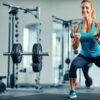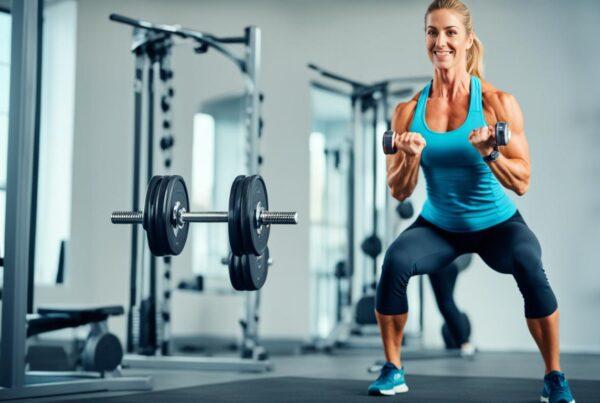Key Takeaways
- Dynamic warmups aren’t just for athletes: Everyone, from weekend warriors to daily walkers, can benefit from incorporating dynamic stretches before engaging in activity.
- It’s about more than just loose muscles: Dynamic warmups enhance performance, reduce injury risk, prime your mind for exercise, and even help you work out more efficiently.
- Forget holding stretches: Dynamic warmups involve continuous, flowing movements that mirror the activity you’re about to undertake.
- Tailor it to your sport: While all dynamic warmups offer benefits, the most effective routines take into account the specific demands of your chosen activity.
- Listen to your body: Choose movements you’re comfortable with, adjust them for your abilities, and prioritize form over speed.
Overview of Dynamic Warmup
Forget those old-school stretches where you stand still and hold a hamstring while counting to 30. Today’s fitness focus is on the dynamic warmup – and for good reason! A dynamic warmup gets your body moving, your heart pumping, and primes your muscles for the challenge ahead. It’s not just about flexibility – it’s about prepping your body for whatever you’re about to throw its way.
Importance in Exercise and Sports
Whether you’re lacing up your running shoes, getting ready to hit the weights, or stepping onto the soccer field, a dynamic warmup is critical to getting the most out of your efforts. Dynamic warm-ups are not just another fitness fad; they are supported by solid science backed by organizations like the National Academy of Sports Medicine (NASM): https://www.nasm.org/. Benefits include injury prevention, enhanced performance, and a whole lot more.
 Understanding Dynamic Warmup
Understanding Dynamic Warmup
What is Dynamic Warmup?
Definition and Core Principles
So, dynamic warmup – what exactly IS it? Think of it as movement with a purpose. Instead of holding a fixed position like a static stretch, dynamic warmups involve continuous, flowing motions that mimic the type of activity you’re about to do. Examples include light jogging, walking lunges, and arm circles. They help elevate your body temperature, increase blood flow to your muscles, and take your joints through their full range of motion.
Dynamic vs. Static Stretching
Comparison and When to Use Each
Dynamic and static stretching both have their place in a fitness routine, but they serve different purposes:
- Dynamic Stretching: Prepares your body for activity and is best performed as a warmup.
- Static Stretching: Improves flexibility over time and is often done post-workout or on its own.
Imagine dynamic warmups as preparing your car’s engine for a drive – you wouldn’t rev it up cold. Likewise, dynamic stretches get your body ready for the work ahead. Static stretches are like the detailing your car gets after a long trip – important, but for a different purpose!
 The Science Behind Dynamic Warmup
The Science Behind Dynamic Warmup
Physiological Benefits
Dynamic warmups aren’t just about feeling loose and limber. They trigger a host of physiological changes that significantly impact how your body performs:
- Increased Muscle Temperature and Blood Flow: Warmer muscles are more pliable and less prone to injury. Dynamic warmup increases blood flow, carrying oxygen and nutrients to your working muscles. Think of it like turning up the heat before cooking – you make everything work better.
- Enhanced Oxygen Delivery and Nutrient Uptake: Oxygen fuels your muscles, allowing them to contract and produce force. A dynamic warmup primes your cardiovascular system to deliver that oxygen more efficiently. It also helps your muscles take up nutrients from your bloodstream, giving you the fuel you need to perform.
Impact on Performance
A proper dynamic warmup doesn’t just make you feel good; it can lead to measurable improvements in your athletic performance:
- Agility, Speed, and Strength: Studies have shown that dynamic warmups can enhance short-term power output, reaction time, and overall athleticism. This translates to quicker sprints, faster changes of direction, and more explosive lifts.
- Reduced Muscle Soreness: When you prepare your muscles properly for activity, you’ll experience less post-workout soreness, allowing you to recover faster and perform better over time.
Key Components of an Effective Dynamic Warmup
Essential Exercises
Examples of Dynamic Movements
The core of your dynamic warmup consists of a collection of specific exercises or movements. Think of these as the building blocks:
- Cardiovascular Warm-up: Start with light cardio, like jogging on the spot, skipping, jumping jacks, or dynamic planks. Get your heart rate going and your blood flowing.
- Leg Swings: Controlled forward, backward, and side-to-side leg swings increase hip mobility. Perform these near a wall or support at first for balance.
- Arm Circles: Move your arms in controlled circles – start small and gradually expand the circles throughout the exercise. Do these both forwards and backward.
- Walking Lunges with Twists: Combine the traditional lunge with an upper body twist. This hits everything from core strength to hip and leg flexibility.
These are just a few examples – many more dynamic exercises are available. Websites like WebMD offer excellent demonstrations and instructions on proper form: https://www.webmd.com/.
Structuring Your Routine
Sequence and Duration Recommendations
Your dynamic warmup should be structured and progressive:
- Light Cardio: Start with around 5 minutes of light cardio to gradually elevate your heart rate.
- Dynamic Movements: Choose 5-8 dynamic movements that target multiple muscle groups. Perform 10-15 repetitions of each.
- Duration: Adjust as needed, but aim for a total warmup time of 8-15 minutes.
Important Note: The right routine will vary depending on your fitness level and the activity you’re about to perform. It’s wise to consult resources like the American Council on Exercise (ACE) to find sport and activity-specific warmup recommendations: https://www.acefitness.org/.
Benefits for Athletes
Enhanced Flexibility and Range of Motion
Athletic performance often demands that you move your body through a wide range of motion. Think of a pitcher throwing a fastball or a gymnast hitting a complex balance beam routine. Dynamic warmups improve your functional flexibility, allowing for more efficient movements and optimal performance.
Injury Prevention
Reducing the Risk of Strains and Sprains
One of the biggest benefits of a dynamic warmup is injury prevention. When your muscles and joints are properly warmed up, they’re less likely to tear or become strained. This is crucial for athletes, as even minor injuries can sideline you for significant amounts of time.
Improved Athletic Performance
Sport-Specific Advantages
A dynamic warmup isn’t just about warm muscles; it also primes your neuromuscular system for the specific demands of your sport. It improves coordination, balance, and power, resulting in a significant performance boost. For example, a soccer player performing lateral shuffles and agility drills as part of a dynamic warmup is directly preparing their body for rapid shifts in direction required in the game.
Benefits for Everyday Fitness Enthusiasts
Boosted Exercise Readiness
Mental and Physical Preparation
Imagine jumping straight off the couch and into a workout. It’s a recipe for sore muscles and subpar performance. A dynamic warmup eases you into your routine, making it feel less jarring, improving your focus, and getting you mentally prepared for the workout.
Increased Heart Rate and Blood Flow
Enhancing Workout Efficiency
By kickstarting your cardiovascular system and increasing blood flow right before your workout, you ensure a steadier supply of oxygen and nutrients to your muscles. This allows you to work out harder for longer and make the most of your gym time.
Additional Benefits
While athletes may focus on maximizing agility and speed, daily fitness enthusiasts will reap numerous other benefits from dynamic warmups:
- Improving Posture: Good posture helps support your joints during both workouts and everyday activities. Regularly performing dynamic warmups enhances body awareness and can lead to posture improvements.
- Enhancing Mind-Body Connection: These warmups aren’t just about muscles; they can help your mind focus on the movements your body is about to perform. This leads to better form and concentration during your workout.
- Reducing Risk of Everyday Injury: From picking up kids to carrying groceries – daily life requires movement. Proper dynamic warmups prepare you for these common activities, making you less prone to aches, strains, and other frustrating injuries.
Dynamic Warmup for Different Sports
While general dynamic warmups are excellent for overall fitness, tailoring them to your specific sport greatly enhances the benefits:
Running
Specific Movements for Runners
Focus on exercises that target common running trouble spots like calves, hamstrings, and hip flexors:
- Butt Kicks: These bring your heels toward your glutes, warming up the backside of your legs and stretching your quads.
- High Knees: Exaggerated marching motion targets hip flexors and engages the core.
- Lateral Leg Swings: Loosen tight hips and get your body used to moving side-to-side.
Swimming
Warmup Techniques for Swimmers
Since swimmers can’t perform traditional jogging, the emphasis in a dynamic warmup changes:
- Out-of-Pool Shoulder Circles and Trunk Twists: These mimic swimming motions while promoting joint and spinal mobility.
- Poolside Squats and Lunges: Target legs and core for powerful kicks and streamlined movements in the water.
- Resistance Band Work: Bands can mimic stroke motions on land, further aiding pre-swim muscle activation.
Team Sports (Soccer, Basketball, etc.)
Tailored Warmups for Group Dynamics
Dynamic warmups in team sports serve both performance and preparation purposes. Emphasize movements critical to the sport:
- Shuttle Runs: Short sprints with changes of direction improve agility and reaction time.
- Cone Drills: Weave in and out of cones to develop quickness and simulate in-game movement patterns.
- Sport-Specific Movement Practice: Dribbling drills in basketball, short passing plays in soccer – integrate actions you’ll be repeating during the game.
Important Considerations: Look for online resources dedicated to your sport for specific exercises and warmup routines. The National Strength and Conditioning Association (NSCA) is often a source of excellent routines: https://www.nsca.com/.
 Age and Dynamic Warmup
Age and Dynamic Warmup
Youth Athletes
- Safety and Adaptability*
Dynamic warmups are incredibly beneficial for young athletes. However, some considerations are necessary:
- Fun and Engagement: Make it playful, turning stretches into games. This makes warming up more appealing, creating positive exercise habits.
- Supervision and Proper Form: Younger athletes need guidance to ensure they’re doing exercises correctly, preventing injury and emphasizing good technique.
- Age-Appropriate Movements Avoid exercises that put excessive strain on developing joints. Websites like Verywell Family provide valuable advice: https://www.verywellfamily.com/.
Adults and Aging Populations
Modifications and Cautions
Dynamic warmups are not exclusive to the young. Adults, especially those facing joint stiffness or mobility issues, can reap significant benefits from these active warmups.
- Gradual Progressions: It’s essential to start slower and with smaller movements, increasing intensity and range of motion over time.
- Listening to Your Body: Pain is a sign to stop. Modify exercises as needed or seek advice from a physical therapist or qualified trainer.
- Medical Considerations: If you have underlying health conditions, it’s best to consult your doctor before incorporating a dynamic warmup routine, particularly a more vigorous one.
Incorporating Dynamic Warmup into Your Routine
Getting Started
Basic Guidelines for Beginners
The best way to make dynamic warmups a habit is to start simple:
- Start Small: Begin with just 5-10 minutes of warmup time before workouts. You can expand the duration as you get accustomed to the exercise and reap the benefits.
- Choose Familiar Movements: Start with moves you know, avoiding overly complex exercises while focusing on proper form.
- Listen to Your Body: This is crucial, especially for beginners. If you feel pain, modify the exercise or stop entirely.
Customizing Your Warmup
Adjusting for Personal Needs and Goals
To maximize the benefits and enjoyment of your warmups, take some time to personalize them:
- Activity Level: A weekend warrior and a competitive athlete have different demands, and that affects warmup complexity and intensity.
- Injury & Limitations: Tailor exercises to accommodate any current or previous injuries. Be careful, and consult a physiotherapist if needed.
- Enjoyment: If you enjoy your warmup, you’re more likely to stick with it. Don’t be afraid to mix it up and try different movements within a dynamic format.
Resources for Finding Exercises
The internet is brimming with valuable resources to build your warmup repertoire:
- YouTube: Videos demonstrate proper form and technique (https://www.youtube.com/)
- Fitness Blogs: Often have warmup routines specific to sports or activity levels.
- Sports Organizations Websites: Provide tailored guidance for athletes in specific disciplines (e.g., USA Swimming offers resources for swimmers https://www.usaswimming.org/)
Common Mistakes to Avoid
Overdoing It
Recognizing Limits to Prevent Overexertion
A warmup serves to prepare your body, not exhaust it. Overly-enthusiastic dynamic warmups can leave you fatigued before your workout even begins. Here’s the key: focus on smooth, controlled motions rather than pushing to absolute maximum effort.
Neglecting Muscle Groups
Ensuring a Holistic Approach
It’s easy to bias your warmup toward areas you use heavily in your chosen activity. Runners may overemphasize leg exercises, neglecting their core and upper body. The most effective dynamic warmups target ALL major muscle groups to prepare your body for well-rounded movement.
Additional Pitfalls
- Insufficient Time: Rushing a warmup undermines its purpose. Make those 5-15 minutes a non-negotiable part of your training.
- Ignoring Form: Don’t sacrifice good form for speed. Incorrect technique can lead to injury and won’t get your body properly prepared.
- Forgetting to Breathe: Breathe deeply and consciously during your warmup, promoting full oxygenation of your muscles for enhanced performance.
Dynamic Warmup and Mental Preparation
Focusing the Mind
Psychological Benefits of a Proper Warmup
Physical benefits aside, a dynamic warmup acts as a mental cue for transitioning into your workout. The act of deliberately moving your body signals to your mind that it’s “go-time.” This focuses your attention and boosts psychological readiness.
Building a Pre-Performance Routine
Creating Consistency and Confidence
Athletes often adopt specific rituals in preparation for competition. Those same concepts can be applied to your workouts. Having a consistent dynamic warmup routine builds habit, reduces potential for “forgetting” it, and creates a powerful signal that tells your body to start performing at its best.
Advanced Techniques and Tools
Use of Resistance Bands
Incorporating Equipment for Enhanced Resistance
Resistance bands are perfect for upping the ante in your dynamic warmup. They introduce external resistance, further boosting muscle activation and preparing your body for more challenging actions:
- Banded Hip Flexor Stretches: Step into a resistance band looped around your feet while in a lunge position. This creates a more dynamic motion as you pull up.
- Overhead Shoulder Presses with Bands: Mimic weight training overhead movements, priming your shoulders with resistance.
- Resistance Band Pull-Aparts: Focus on engaging your back and shoulders, particularly useful for activities requiring upper-body strength and good posture.
Incorporating Plyometrics
Explosive Movements for Power and Endurance
Plyometrics involve explosive power-focused movements. They are best when your body is primed by a dynamic warmup, NOT as a primary warmup in themselves. This prevents injury and optimizes your athletic potential:
- Box Jumps: Work on explosiveness and lower body power.
- Burpees: A full-body plyometric move demanding a dynamic response from multiple muscle groups.
- Lateral Jumps: Improve agility and the ability to quickly change direction.
Important! Use plyometrics judiciously and with proper form. As your muscles tire, stop to prevent injuries. Websites like ACE Fitness (https://www.acefitness.org/) and STACK (https://www.stack.com/) are good resources for safe and effective plyometric variations.
Comparative Analysis
Dynamic Warmup in Various Training Regimes
It’s worth noting that dynamic warmups have achieved wide-ranging acceptance and adoption across various fitness methodologies. Here’s how they are commonly incorporated:
- Strength Training: Lifting heavy weights demands prepared muscles and joints. Dynamic warmups are favored in powerlifting and Olympic lifting due to their focus on range of motion and explosiveness.
- HIIT (High-Intensity Interval Training): HIIT is characterized by rapid shifts in intensity. A dynamic warmup primes the heart and muscles for this fast-paced format.
- Yoga: While less vigorous than some disciplines, many yoga routines utilize dynamic elements. Think Sun Salutations or flow sequences to elevate body temperature and increase flexibility before delving into static holds.
- Bodyweight Training: Often relying on compound movements, bodyweight exercises also benefit from muscle activations triggered by dynamic warmups, optimizing form and performance.
Testimonials and Case Studies
Real-world Applications and Success Stories
Beyond training methodologies, many testimonials and published case studies illustrate the tangible benefits of dynamic warmups:
- Reduced Injury Rates: Numerous studies report correlations between dynamic warmups and lower injury prevalence in sports teams and fitness groups.
- Performance Improvements: Data suggests athletes employing dynamic warmups often exhibit measurable gains in power, agility, and speed compared to those who only perform static stretching or those who skip a warmup entirely.
- Subjective Reports: Individuals often note feeling more mobile, less pain during or after training, and enhanced workout focus following a regular dynamic warmup routine.
FAQs
Q: Can I replace static stretching with dynamic warmups?
A: Dynamic warmups are best before workouts, while static stretching serves a different purpose – enhancing flexibility over time. It’s ideal to include both in your fitness routine.
Q: How long should my dynamic warmup be?
A: For most people, 8-15 minutes is ideal. But it’s adjustable based on your fitness level and workout intensity.
Q: Are dynamic warmups only for athletes?
A: Absolutely not! Casual exercisers benefit significantly from improved range of motion, injury prevention, and a smoother transition into physical activity.
Q: Can I design a warmup routine myself?
A: Yes! Many online resources offer guidance and video demonstrations of dynamic warm-up exercises. However, if you have medical concerns or significant injuries, it’s wise to consult a doctor or physical therapist for personalized advice.
Q: I feel stiff when I start my dynamic warmup. Is that normal?
A: Some initial stiffness is common, especially as you start using these routines. Your body will warm up and adapt as you consistently use dynamic warmups. If you experience pain, stop the exercise and modify or consult a professional.
Conclusion
Summarizing the Importance and Benefits of Dynamic Warmup
Dynamic warmups, when executed properly and consistently, offer significant benefits for athletes and everyday fitness enthusiasts alike. From enhanced performance to injury reduction, these “warmups with a purpose” enhance overall fitness and make every workout better.
Encouraging Regular Implementation for Optimal Performance and Health
If you haven’t yet integrated dynamic warmups into your workout routine, now is the perfect time to start. Take advantage of the many resources available to find movements that suit your sport or activity level. With commitment, you’ll soon reap the tangible rewards dynamic warmups bring to your physical well-being and performance.


 Understanding Dynamic Warmup
Understanding Dynamic Warmup The Science Behind Dynamic Warmup
The Science Behind Dynamic Warmup Age and Dynamic Warmup
Age and Dynamic Warmup





